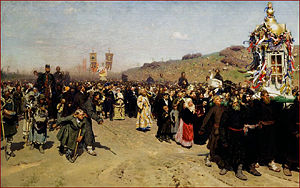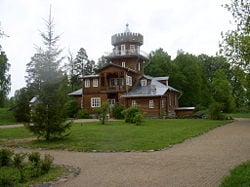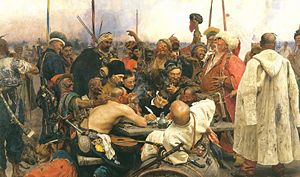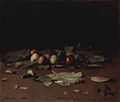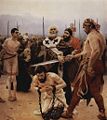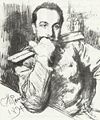Ilya Yefimovich Repin
Ilyá Yefímovich Répin (Илья́ Ефи́мович Ре́пин) (August 5 1844, Ukraine (Julian calendar: July 24) – September 29 1930, Kuokkala, Finland) was a leading Russian painter and sculptor of the Peredvizhniki artistic school. His realistic works often expressed great psychological depth and exposed the tensions within the existing social order. Beginning in the mid-1920s, a Repin cult was established in the Soviet Union; he was held up as a model "progressive" and "realist" to be imitated by Socialist Realist artists in the USSR.
Life and Work
Repin was born in the town of Chuguev near Kharkov in the heart of the historical region called Sloboda Ukraine. His parents were Russian military settlers. In 1866, after apprenticeship with a local icon painter named Bunakov and preliminary study of portrait painting, he went to Saint Petersburg and was shortly admitted to the Imperial Academy of Arts as a student. From 1873 to 1876 on the Academy's allowance, Repin sojourned in Italy and lived in Paris, where he was exposed to French impressionist painting, which had a lasting effect upon his use of light and color. Nevertheless, his style was to remain closer to that of the old European masters, especially Rembrandt, and he never became an impressionist himself. Throughout his career, he was drawn to the common people from whom he traced his origins, and he frequently painted country folk, both Ukrainian and Russian, though in later years he also painted members of the Imperial Russian elite, the intelligentsia, and the aristocracy, including Tsar Nicholas II of Russia.
The itinerants
In 1878, Repin joined the free-thinking "Association of Peredvizhniki Artists", generally called "the Wanderers" or "The Itinerants" in English, who, at about the time of Repin's arrival in the capital, rebelled against the academic formalism of the official Academy. His fame was established by his painting of the "Volga Barge Haulers", a work which portrayed the hard lot of these poor folk but which was not without hope for the youth of Russia. From 1882 he lived in Saint Petersburg but frequently visited his Ukrainian homeland and on occasion made tours abroad.
Historical and contemporary subjects
Beginning shortly before the assassination of Tsar Alexander II of Russia in 1881, he painted a series of pictures dealing with the theme of the Russian revolutionary movement: "Refusal to Confess", "Arrest of a Propagandist", "The Meeting", and "They did not Expect Him", the last of which is undoubtedly his masterpiece on the subject, mixing contrasting psychological moods and Russian and Ukrainian national motifs. His large-scale "Religious Procession in the Province of Kursk" is sometimes considered an archetype of the "Russian national style" displaying various social classes and the tensions among them set within the context of a traditional religious practice, united by a slow but relentless forward movement.
In 1885, Repin completed one of his most psychologically intense paintings, "Ivan the Terrible and his Son." This canvas displayed a horrified Ivan embracing his dying son, whom he had just struck and mortally wounded in an uncontrolled fit of rage. The visage of terrified Ivan is in marked contrast with that of his helpless son.
One of Repin's most complex paintings, "The Reply of the Zaporozhian Cossacks to Sultan of Turkey" occupied many years of his life. He conceived this painting as a study in laughter, but also believed that it involved the ideals of liberty, equality, and fraternity; in short, Ukrainian Cossack republicanism. Begun in the late 1870s, it was only completed in 1891, and, ironically, was immediately purchased by the Tsar. The Tsar paid 35,000 rubles for the painting, the largest amount ever paid for a Russian painting to that time.
During his maturity, Repin painted many of his most celebrated compatriots, including the novelist Leo Tolstoy, the scientist Dmitri Mendeleev, the imperial official Konstantin Pobedonostsev, the composer Modeste Mussorgsky, the philanthropist Pavel Tretyakov, and the Ukrainian poet and painter, Taras Shevchenko.
In 1903 he was commissioned by the Russian government to paint his most grandiose design, a 400 x 877 cm canvas representing a ceremonial session of the State Council of Imperial Russia.
Later life
Repin himself designed his home Penaty (literally, "the Penates"), located just to the north of Saint Petersburg. After the Russian Revolution of 1917, Penaty was incorporated into Finland. He was invited by Vladimir Lenin to come back to Russia but refused the invitation, using the excuse that he was too old to make the journey. With the exception of a portrait of Provisional Government head, Alexander Kerensky, he never painted anything substantial on the subject of the 1917 revolutions or the Soviet experiment that followed. His last painting, "The Hopak", was on a Ukrainian Cossack theme. In 1930, he died in Kuokkala, Finland (now Repino, Leningrad Oblast). The Penates are part of the World Heritage Site Saint Petersburg and Related Groups of Monuments.[1] In 1940, Penaty was opened for the public as a house museum. Alexander Glazunov's Oriental Rhapsody, Op. 29 (1889) is dedicated to Ilya Repin.
Bibliography
- Fan Parker and Stephen Jan Parker, Russia on Canvas: Ilya Repin (University Park-London: Pennsylvania State UP, 1980). Repeats the standard Soviet interpretation of Repin's life and work.
- Grigory Sternin and others, Ilya Repin: Painting Graphic Arts (Leningrad: Aurora, 1985). Standard Soviet treatment, but well illustrated.
- Elizabeth Kridl Valkenier, Ilya Repin and the World of Russian Art (New York: Columbia UP, 1990). Critical non-Soviet treatment with much fresh information, but geared primarily toward academics.
Paintings
Repin's paintings appear in the following Wikipedia articles:
- Peredvizhniki | Cossacks | State Council of Imperial Russia | Ivan IV of Russia | Krestny khod | Myra | Tsardom of Russia | Sadko | Eudoxia Streshneva | Sophia Alekseyevna | Modest Mussorgsky | Dmitry Mendeleyev | Gavriil Derzhavin | Tsarskoye Selo Lyceum | Anton Rubinstein | Aleksey Pisemsky | Konstantin Pobedonostsev | Sergius Witte | Pavel Tretyakov | Afanasy Fet | Vladimir Stasov | Alexander Glazunov | Leo Tolstoy
Ivan the Terrible and his son Ivan 1870-1873
Burlaks on Volga , 1870-73
- Grandukesbride.jpg
Grand Duke Choosing His Bride 1885
Portrait of Leo Tolstoy 1887
Portrait of Leo Tolstoy 1893
Composer Modest Mussorgsky
Konstantin Pobedonostsev (sketch)
Pushkin Reciting His Poem Before Old Derzhavin (1911)
External links
- Ilya Repin at Olga's Gallery
- Repin's paintings at The Russian Art Gallery
- Penaty, currently a museum
Credits
New World Encyclopedia writers and editors rewrote and completed the Wikipedia article in accordance with New World Encyclopedia standards. This article abides by terms of the Creative Commons CC-by-sa 3.0 License (CC-by-sa), which may be used and disseminated with proper attribution. Credit is due under the terms of this license that can reference both the New World Encyclopedia contributors and the selfless volunteer contributors of the Wikimedia Foundation. To cite this article click here for a list of acceptable citing formats.The history of earlier contributions by wikipedians is accessible to researchers here:
The history of this article since it was imported to New World Encyclopedia:
Note: Some restrictions may apply to use of individual images which are separately licensed.

